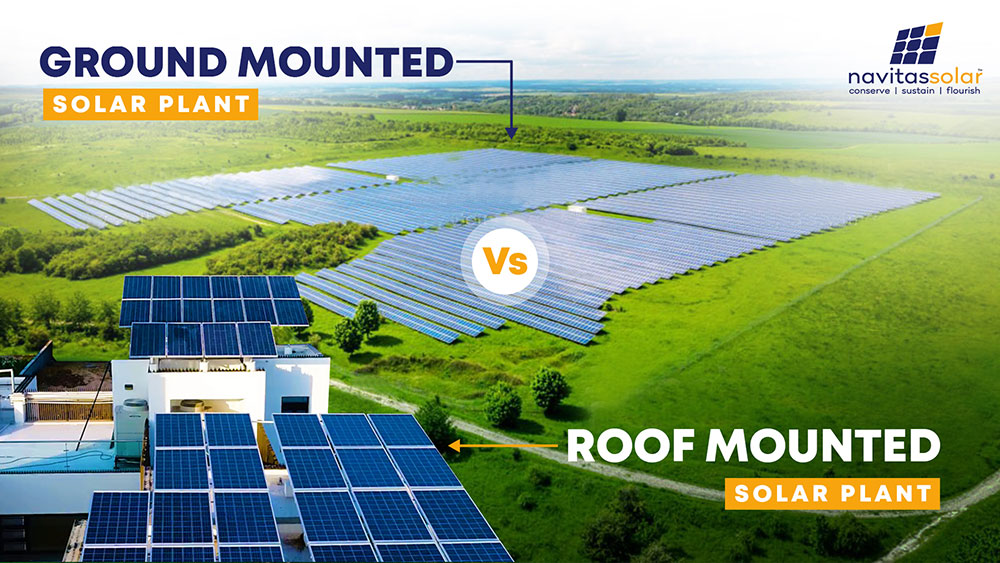Navitas Blog Solar System Comparison English 2004-2022
Thinking of going solar? Let’s compare
roof-mounted and ground-mounted systems
The solar energy generation systems across the world are getting better and more affordable every day, thanks to falling costs, ever-improving technology, and an influx of solar system developers. More and more people are going for solar systems as a result of the ongoing push for renewable energy adoption.
If you too are considering adopting a solar system for your home, soon you will face a dilemma – Should you install your solar panels on your roof or create a separate ground mount?
Both have their pros and cons. With the numerous pressures acting on a solar panel, such as its weight, precipitation or dirt on top of it, as well as wind, rain, or earthquake stresses, adequate racking solutions are necessary. As a result, the panel’s mounting mechanism should endure the forces involved.
We will have a detailed comparison, but quickly we can say that roof-mounted solar panel packages are less expensive to install and take up less space. While ground-mounted solar panels take up more room, they’re easier to place in the ideal location to maximize your array’s output. They’re also easier to clean and maintain regularly.
Having said that, for most home solar installations, roof-mounted solar panels are the best option. It’s the most typical way to set up solar panels. The roof serves as the solar system’s foundation. Those who live in the city appreciate this option the most. Because many residential homes have limited yard space, homeowners frequently choose to build their systems on their roofs to save room.
Roof-mounted solar panels provide the advantage of utilizing your home’s existing support structure to serve as a foundation for your solar array. If you have limited space on your property, then also roof-mounted solar panels are the best option. After all, what else are you going to do with that room? It’s a good idea to install your system on your roof and use the space in your yard for something more beneficial.
There are a few drawbacks to roof-mounted solar panels too. They require proper orientation to get the most out of them and It’s unlikely that you’ll acquire the “ideal” orientation for your rooftop solar installation. Your options are restricted by the amount of buildable area on your roof. Then, not every rooftop has enough room for huge solar panels. Rooftop solar panels make use of vacant space, but they’re also more difficult to install and maintain. Solar panels should be cleaned once a year to keep them clear of dust and debris that could reduce their efficiency. Cleaning the roof-top panels is not easier.
Now, if we talk about ground-mounted panels, if you want to maximize your system’s output, this option makes sense. It also provides convenient access to continuous care. In large-scale installations, ground mounts are very popular. Larger panels can be used, and the array can be angled to maximize production. They have the advantage of allowing you to build your panels in the best available position and orient them to maximize your system’s output.
But when it comes to the costs, ground-mount systems have a significant disadvantage in terms of installation costs, which is why most people opt for a roof-mounted array.
If you are still unable to decide which option is ideal for you, experts at Navitas, a Surat, Gujarat based leading provider of end-to-end solar systems, can help you out. Navitas provide solar equipment, design, and permitting services for both residential and commercial solar projects. You can easily get in touch with Navitas for a free design consultation if you’re ready to go solar.


 Online | Privacy policy
Online | Privacy policy
Related Posts
You May Also Like
Bonito Series: Driving Innovation in…
Read MoreTOPCon Series: The Next Generation…
Read MoreValuable Points to Remember During…
Read MoreNavitas Planet Partners with Hysolwin…
Read MoreDriving Towards a Sustainable Future:…
Read MoreWhy Do Top-Grade EVA Sheets…
Read MoreBonito Series: Driving Innovation in…
Read MoreTOPCon Series: The Next Generation…
Read MoreValuable Points to Remember During…
Read MoreNavitas Planet Partners with Hysolwin…
Read MoreDriving Towards a Sustainable Future:…
Read MoreWhy Do Top-Grade EVA Sheets…
Read MoreBonito Series: Driving Innovation in…
Read MoreTOPCon Series: The Next Generation…
Read MoreValuable Points to Remember During…
Read MoreNavitas Planet Partners with Hysolwin…
Read More